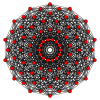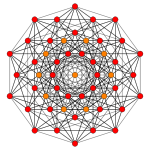 7-orthoplex |
 Rectified 7-orthoplex |
 Birectified 7-orthoplex |
 Trirectified 7-orthoplex |
 Birectified 7-cube |
 Rectified 7-cube |
 7-cube | |
| Orthogonal projections in B7 Coxeter plane | |||
|---|---|---|---|
In seven-dimensional geometry, a rectified 7-orthoplex is a convex uniform 7-polytope, being a rectification of the regular 7-orthoplex.
There are unique 7 degrees of rectifications, the zeroth being the 7-orthoplex, and the 6th and last being the 7-cube. Vertices of the rectified 7-orthoplex are located at the edge-centers of the 7-orthoplex. Vertices of the birectified 7-orthoplex are located in the triangular face centers of the 7-orthoplex. Vertices of the trirectified 7-orthoplex are located in the tetrahedral cell centers of the 7-orthoplex.
Rectified 7-orthoplex
| Rectified 7-orthoplex | |
|---|---|
| Type | uniform 7-polytope |
| Schläfli symbol | r{3,3,3,3,3,4} |
| Coxeter-Dynkin diagrams | |
| 6-faces | 142 |
| 5-faces | 1344 |
| 4-faces | 3360 |
| Cells | 3920 |
| Faces | 2520 |
| Edges | 840 |
| Vertices | 84 |
| Vertex figure | 5-orthoplex prism |
| Coxeter groups | B7, [3,3,3,3,3,4] D7, [34,1,1] |
| Properties | convex |
The rectified 7-orthoplex is the vertex figure for the demihepteractic honeycomb. The rectified 7-orthoplex's 84 vertices represent the kissing number of a sphere-packing constructed from this honeycomb.










 or
or 












Alternate names
- rectified heptacross
- rectified hecatonicosoctaexon (Acronym rez) (Jonathan Bowers) - rectified 128-faceted polyexon[1]
Images
| Coxeter plane | B7 / A6 | B6 / D7 | B5 / D6 / A4 |
|---|---|---|---|
| Graph | 
|

|

|
| Dihedral symmetry | [14] | [12] | [10] |
| Coxeter plane | B4 / D5 | B3 / D4 / A2 | B2 / D3 |
| Graph | 
|

|

|
| Dihedral symmetry | [8] | [6] | [4] |
| Coxeter plane | A5 | A3 | |
| Graph | 
|

| |
| Dihedral symmetry | [6] | [4] |
Construction
There are two Coxeter groups associated with the rectified heptacross, one with the C7 or [4,3,3,3,3,3] Coxeter group, and a lower symmetry with two copies of pentacross facets, alternating, with the D7 or [34,1,1] Coxeter group.
Cartesian coordinates
Cartesian coordinates for the vertices of a rectified heptacross, centered at the origin, edge length are all permutations of:
- (±1,±1,0,0,0,0,0)
Root vectors
Its 84 vertices represent the root vectors of the simple Lie group D7. The vertices can be seen in 3 hyperplanes, with the 21 vertices rectified 6-simplexs cells on opposite sides, and 42 vertices of an expanded 6-simplex passing through the center. When combined with the 14 vertices of the 7-orthoplex, these vertices represent the 98 root vectors of the B7 and C7 simple Lie groups.
Birectified 7-orthoplex
| Birectified 7-orthoplex | |
|---|---|
| Type | uniform 7-polytope |
| Schläfli symbol | 2r{3,3,3,3,3,4} |
| Coxeter-Dynkin diagrams | |
| 6-faces | 142 |
| 5-faces | 1428 |
| 4-faces | 6048 |
| Cells | 10640 |
| Faces | 8960 |
| Edges | 3360 |
| Vertices | 280 |
| Vertex figure | {3}×{3,3,4} |
| Coxeter groups | B7, [3,3,3,3,3,4] D7, [34,1,1] |
| Properties | convex |
Alternate names
- Birectified heptacross
- Birectified hecatonicosoctaexon (Acronym barz) (Jonathan Bowers) - birectified 128-faceted polyexon[2]
Images
| Coxeter plane | B7 / A6 | B6 / D7 | B5 / D6 / A4 |
|---|---|---|---|
| Graph | 
|

|

|
| Dihedral symmetry | [14] | [12] | [10] |
| Coxeter plane | B4 / D5 | B3 / D4 / A2 | B2 / D3 |
| Graph | 
|

|

|
| Dihedral symmetry | [8] | [6] | [4] |
| Coxeter plane | A5 | A3 | |
| Graph | 
|

| |
| Dihedral symmetry | [6] | [4] |
Cartesian coordinates
Cartesian coordinates for the vertices of a birectified 7-orthoplex, centered at the origin, edge length are all permutations of:
- (±1,±1,±1,0,0,0,0)
Trirectified 7-orthoplex
A trirectified 7-orthoplex is the same as a trirectified 7-cube.
Notes
References
- H.S.M. Coxeter:
- H.S.M. Coxeter, Regular Polytopes, 3rd Edition, Dover New York, 1973
- Kaleidoscopes: Selected Writings of H.S.M. Coxeter, edited by F. Arthur Sherk, Peter McMullen, Anthony C. Thompson, Asia Ivic Weiss, Wiley-Interscience Publication, 1995, ISBN 978-0-471-01003-6 [1]
- (Paper 22) H.S.M. Coxeter, Regular and Semi Regular Polytopes I, [Math. Zeit. 46 (1940) 380–407, MR 2,10]
- (Paper 23) H.S.M. Coxeter, Regular and Semi-Regular Polytopes II, [Math. Zeit. 188 (1985) 559-591]
- (Paper 24) H.S.M. Coxeter, Regular and Semi-Regular Polytopes III, [Math. Zeit. 200 (1988) 3-45]
- Norman Johnson Uniform Polytopes, Manuscript (1991)
- N.W. Johnson: The Theory of Uniform Polytopes and Honeycombs, Ph.D.
- Klitzing, Richard. "7D uniform polytopes (polyexa)". o3x3o3o3o3o4o - rez, o3o3x3o3o3o4o - barz

